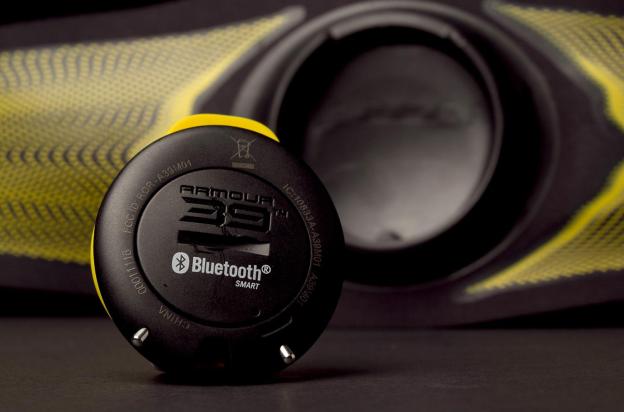“Armour39 is unusual in the fitness tech space for its laser focus on the quality of individual workouts, but this strength is also its greatest weakness.”
- Simple, efficient data readouts
- Effectively inspires harder workouts
- Low quality strap
- Limited fitness data detail
- No social sharing, ranking, or comparing with peers
- No web interface for data analysis
- Not Android compatible
Ever see those CrossFit fanatics sweating away like Lawnbird sprinklers in your local park? They’re throwing kettlebells into the air, then dropping them and running wind sprints for 30 seconds, then whipping high frequency sine waves into two really large ropes, then busting out 20 burpies? Ever wish you were doing the very same thing? Or maybe you are that guy or gal and want to kick your badass workouts up a couple notches. If so, athletic super brand Under Armour has some new technology that might be just what you’re looking for. It’s a $149 IOS app and heart rate monitor called Armour39.
Features and design
Armour39 is a lushly designed Apple IOS app and accompanying Bluetooth Smart heart monitor and motion module that sits in a nylon chest strap and works in tandem to provide real-time feedback during most any kind of training workout. The app (which we tested on an iPhone 5) features dazzling graphics, stunning video game quality sound effects, and an easy-to-follow interface that will get you pushing your workouts harder than you ever thought possible.
The Armour39 app is made up of four main sections: Settings, Workout, Assessment, and Calendar.
In the Settings you enter personal information like name and email (it is a free app after all, and Under Armour needs something in return) along with age, weight, gender, and max heart rate.

Workout mode is the section you tap into when you’re exercising. It is the workout dashboard that displays your real-time heart rate, intensity level, calories burned, and the core of Armour39 – something Under Armour calls “WILLpower.”
WILLpower is a metric Under Armour invented (and trademarked, thank you very much), which is based on an “algorithm that combines how long you work out, what you did,” coupled with the profile info entered in the settings. It apparently mixes age, weight, and gender data with heart rate and motion measurements taken from the module and computes a score on a scale of one to 10. The number is designed as an easy-to-understand metric showing exactly how intense a particular workout was. WILLpower helps you compare previous recorded workouts and plan new ones that are either similar or more (or less) intense. Workout mode also lets you set WILLpower goals to help you stay focused on taking the intensity to a specific level.
In Assessment mode, you put on headphones and are talked through a 10 minute fitness assessment by San Diego-based trainer to the NFL super stars, Todd Durkin. While you do the work, Durkin explains exactly what to do and how long to do it right into your headphones. Under Armour says the assessment is something that should be done once a month to track fitness improvement.
The Calendar is a simple archive of completed workouts saved in a list by date along with individual screens showing workout heart rate, intensity, willpower, and calories burned charted over the past 30 workouts. It is the only way to view and analyze past workouts.
In the upper right hand corner of the app (on all screens) is a music button that provides total control over music during a workout or assessment without having to leave the app.
Aside from a link to the Under Armour store at UA.com that’s all there is to Armour39. Strangely, in this era of fitness over share and the “quantified self,” Armour39 has no social media functions at all. No sharing buttons to blast a WILLpower score to a social stream on Facebook or Twitter. No website that collects WILLpower data from the rest of the world so you can compare your workout with others. No way to be humbled or destroy anyone else’s will power score with your mad workout skills. And, finally, there is no way to upload the workout data to a web interface or to any other service. Armour39 is a stand alone island of pain designed specifically for the individual to push their own solitary training. It almost seems as selfish and narcissistic as some of the people we see working out.
Performance and use
When we unboxed our Armour39 and slipped the strap around our chest it was just before heading out on a short run to a park to kick a soccer ball around. The strap was not as elastic as the heart rate monitors that we’re used to and was not all that easy to get into. It connects with a bra-style hook on the right side and after trying to hook it in place we eventually realized you just have to hook it in front and then slide it around until the strap is in place. Had we asked our wife, this would have taken far less time.
We read a bit of the documentation (there wasn’t much), turned on the Bluetooth on our iPhone 5, snapped the module into the strap to turn it on and everything synced up nicely. Once it was running we figured Amour39 would be similar to other fitness tracking devices that we’ve tried recently. We thought we’d put the phone in our pocket, do the run, and then come home and analyze the data later after uploading it to our computer. Nope. On returning from the run we realized a couple things: one, there wasn’t very much data detail to view, and two, there was no way to upload the info to a computer. The only way we could interact with any of the saved metrics was on our iPhone.
The benefits are only in the workout, and if you’re that kind of training spartan then maybe Armour39 is for you.
On the data side, the Armour39 app only reports the duration of a workout, the average heart rate (with max rate), average intensity, how many calories were burned, and the willpower score (ours was an abysmal l 1.96 out of 10). It was all great data to have, but not anything to spend hours noodling over. That’s when we realized that in our haste to get out and run we’d missed the point of the Armour39 all together: real-time workout monitoring.
While archiving workout data is important for planning future workouts, where the Armour39 excels is in the live, in-the-now data that streams via Bluetooth to the iPhone. It is by using the app as a workout dashboard that it begins making sense. Watching the numbers moving encourages you to work harder, push longer, and be tougher. That is also why the accessory watch that UnderArmour sells (but we didn’t test) is probably a good idea for anyone who wants to get the most from this app. Running it in Google Glass would be even better.
On our second run we decided to do an assessment; this is where we began to see even greater potential for systems like Armour39. It is advised that the assessment be performed on a treadmill or a track, but all we had was our neighborhood and the seawall at the beach so we went with it. We cued our music and tapped the blue “Start Assessment” button. The voice of the trainer Todd Durkin came on to tell us to start walking as a warm up. His voice was perfectly synced to a timer that came up on the screen letting us know how much longer we needed to walk. As the clock counted down the volume of the music lowered and the Durkin’s calm, professional voice came on to tell us to pick up the pace a little, but not to go that hard. The coach-in-the-ear style of assessment mode was amazing and made us wish there were audio comments from a trainer during the workout mode as well. Hearing Durkin telling us to give it more would have pushed us on. And hearing him say “Well, done” after every workout would almost be worth the Armour39’s $149 price tag by itself.

On our third test we ran with our iPhone in our hand, watching our stats as we ran up down stairs and along the beach. It was easy to see on the phone when we were lagging, as our numbers began falling off. The heart rate would drop, the intensity meter would plummet. We realized immediately that we’d have to do all those gnarly beast exercises we see people doing if we really wanted to blast our WILLpower rankings up out of the 2.3 range.
It’s worth noting, as well, that the Armour30 chest strap is neither particularly comfortable or high quality. It became annoying to wear for long periods of time and gave the impression that it would not wear particularly well
Conclusion
Armour39 could be a great training monitor for people who frequent gyms or do CrossFit style programs where different kinds of equipment are used and the only way to rate the workout is through constant heart rate and motion readouts. While runners, cyclists, and swimmers would have no problem using the Armour39 during general fitness training, Amour39 is not something that could be used while doing their chosen activities. This is especially true for swimmers, as Armour39 is in no way water resistant.
Not being able to upload the data to a computer was a huge downside especially as the app will only store 120 workouts. And being forced to view past workouts on the iPhone screen and only in pre-configured data sets was a disappointment, as was the lack of social sharing and/or rankings.
Armour39 is a good tool to follow the intensity of your workout while you’re working out, but past that it’s a letdown. What good is fitness data it if you can’t dissect it more deeply later and share and compare it with your friends. We’re pretty sure Under Armour will say that the benefits are all in the workout, and if you’re that kind of training spartan then maybe Armour39 is for you. As for us, $149.00 is a little too much to pay for a Bluetooth heart rate monitor with a WILLpower metric that no one else will understand, and a memory that will likely fill up in under six months.
Highs
- Simple data readouts
- Willpower score
- The coach-in-the-ear assessment mode
Lows
- Strap was not elastic enough and difficult to hook
- Limited fitness data detail
- No social sharing, ranking, or comparing to other athletes
- Data is not transportable
- No web interface for further analysis







